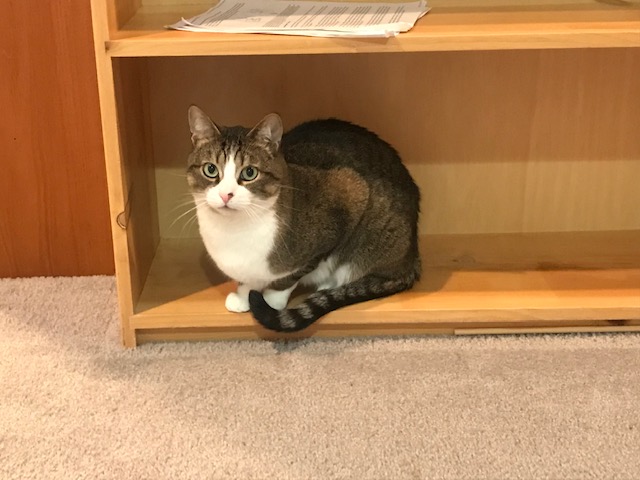
Welcome
Quote of the Day
Quote of the day goes here
I am Edward Muller, author of several short stories which have appeared in Analog Science Fiction and Fact and other magazines, programmer responsible for a bunch of code including the famous Antimatter Calculator.
Over 24,000 words sold!
The Antimatter Calculator
Ensign Garrovick: "Just think, Captain. Less than one ounce of antimatter here, it's more powerful than ten thousand cobalt bombs."
Captain Kirk: "Let's hope it's as powerful as man will ever get."
The truth about the destructive potential of antimatter is considerably less dramatic. One ounce of antimatter equates to 1.22 megatons, which is comparable to a single modern day H-bomb. In order to help prevent such mistakes from occurring in the future, I present the anti-matter caculator. Just plug in the amount of antimatter you're thinking of using and the calculator will return just how much destructive force it contains.
The Antimatter Calculator - Comparative Kabooms
To put things in perspective, here are some famous explosions from history and theory along with their yields:
| Event | Yield |
|---|---|
| Seymour Narrows, British Columbia 1958. 1,375 tons of chemical explosives. | 1.375 kilotons |
| Little Boy, the atomic bomb dropped on Hiroshima, Japan on August 6, 1945. | 13 kilotons. |
| Fat man, the atomic bomb dropped on Nagasaki, Japan on August 9, 1945. | 20 kilotons. |
| One ounce of antimatter | 1.22 megatons |
| Starfish Prime, July 9, 1962. Detonation of a Hydrogen bomb at 16 degrees, 28 minutes North latitude, 169 degrees, 38 minutes West longitude, 250 miles altitude. | 1.45 megatons |
| The Tanguska / Tunguska Event (spelling is in dispute), suspected comet impact in Tanguska, Russia on June 30, 1908. | 10 megatons |
| The Bravo test, one of the Bikini Atoll bomb tests. February 1954, was, at 15 megatons, the most powerful bomb ever detonated by the United States--far bigger than expected. | 15 megatons |
| One pound of antimatter | 19.5 megatons |
| Mount St. Helens May 18, 1980. | 24 megatons |
| The 2004 Indian Ocean earthquake. December 26, 2004 at 00:58:53 UTC. An undersea earthquake with an epicentre off the west coast of Sumatra, Indonesia. The earthquake generated a tsunami that is considered one of the deadliest natural disasters in history. | 26.3 megatons |
| Tsar Bomba, the largest nuclear weapon ever detonated 11:32 AM 30 October 1961 (Moscow Time) Such a device could be souped up to deliver a 100 megaton blast. | 50 megatons |
| The third 1883 eruption of Krakatoa | 150 megatons |
| Hurricane Katrina hitting the Gulf Coast. At full power, a hurricane like Katrina releases 10 megatons every 20 minutes. | 300 megatons |
| World War III, computed as the simultaneous explosion of all known nuclear devices (about 15,000 today). | 10,000 megatons |
| "Dinosaur Killer" Impact of 10-15 km asteroid traveling at 20 kilometers per second. | 100,000,000 megatons or 10^8 megatons |
| The destruction of Alderan, which I computed as the amount of energy required to give an Earth-sized planet its own escape velocity. | 819,083,688.72 megatons |
| A supernova, an explosion powerful enough to destroy a solar system. | one billion billion billion megatons or 10^27 megatons |
The Antimatter Calculator - The Math
Several people have asked to see the math behind the calculations above.
We start with Einstein's famous equation E = M*C^2
(The energy contained within a given amount of mass = That mass times the speed of light squared)
E is expressed in joules, which is kilograms times (meters/second)^2, so the first thing is to convert 1 pound into it's equivalent in kg.
(A few people who wrote me on this had problems because they used grams instead of kilograms. If your answer is 1,000 times greater than mine, that's your problem)
1 ounce equates to 0.02835 kilograms (rounding to 5 decimal places).
Aside:
Be careful here. Pounds are a measure of weight and kilograms
are a measure of mass. An objects weight can vary while its mass
remains constant. I presume here that we're talking one pound of mass at
sea level on earth halfway between the equator and one of the poles. I never saw
Captain Kirk on a planet that didn't have 9.8 m/s^2 for some reason.
Aside
English to metric conversion was the real killer on this project.
Also, we have to annihilate the antimatter with an equal amount of matter, so 2 * 0.02835 = 0.05670 kg.
Aside:
Anti-matter annihilation expresses its energy as a burst of high-frequency gamma
radiation and high-speed neutrinos. Drop a pound of antimatter on the floor and you'll
see a bright flash of light and then nothing else for the remainder of your very short
life! The difficulty in getting antimatter to "blow up" is one reason why the
US never developed an antimatter bomb.
(0.05670 kg) * (2.9979e8 m/s ^ 2) = 5.09577E+15 joules
There are 4.18e15 joules in a megaton, so 5.09577E+15 joules dvided by 4.18e15 equates to 1.21908 megatons.
The Antimatter Calculator - How Did Antimatter Get To Be So Over-rated?
I blame television in general and Star Trek in particular.
While developing the pilot for this new series, Gene Roddenberry asked a number of scientists for feedback on his pilot script The Cage. One of the points brought up was the power source for the ship. Here's the relevant quote on the subject from The Making of Star Trek by Stephen E. Whitfield and Gene Roddenberry:
Discussions with scientific consultants had already ruled out atomic power as inefficient and inadequate for achieving hyper-light speeds. Ion drive was ruled out for the same reason.
Finally, the conclusion reached was that the only power source conceivably large enough to do the job would be the energy released by the sheer annihilation of matter and anti-matter. This had already been achieved on a minute scale by several research laboratories. Theoretical release of such power, on Star Trek's scale, compares to nuclear energy as an H-bomb compares to a kitchen match!
Now the statement compares to nuclear energy as an H-bomb compares to a kitchen match! is very dramatic and impressive-sounding, but not terribly helpful for calculating exact yields. Most of the writers who wrote for Star Trek were not scientists or even science-fiction writers, which meant the above statement was all that they had to work with.
The Antimatter Calculator - References
Star Trek (Original Series, season 2) Obsession Writer: Art Wallace. Directed by Ralph Senensky Stardate 3619.2, airdate 12/15/1967
Star Trek Concordance Copyright (C) 1976 by Paramount Pictures Corporation and Bjo Trimble ISBN 0-345-25137-695
The Making of Star Trek Copyright (C) 1968 by Stephen E. Whitfield SBN 345-24691-8-195
Biography

Edward Muller is a CPA & computer programmer who lives and works in Vancouver, Washington along
with his wife, Dr. Tera Rich, and a pride of four cats. He got interested in
writing at age five when his Aunt Anne transcribed one of his spoken stories and
showed him what his words looked like on paper. In his early teens he started
watching Star Trek and soon migrated to reading Sir Arthur Clarke, Robert Heinlein,
and Larry Niven. His first published work was the short story Charity's Case
in the Autumn 2000 edition of Artemis Magazine. Since then he has been published in
several magazines including Analog.
Bibliography
| Title | Publishing History |
|---|---|
| Prizes | All Possible Worlds March 2007 |
| Edges | Flashing Swords Issue 4, Fall 2005 |
| Gun Control | Analog - Science fiction and fact November 2004 |
| The First Lesson | Analog - Science fiction and fact September 2003 |
| Birthright | Artemis - Science and fiction for a space-faring age Summer 2002 |
| Charity's Case | Artemis - Science and fiction for a space-faring age Autumn 2000 |
Pictures of Cats
Recipies
Chocolate Chip Cheesecake
Chocolate Chip Cheesecake Made this for my neice one year. She must have liked it because she requested it the next year, and the year after that.
There is a school of thought that placing a shallow pan of hot water directly below the cheesecake on the next oven rack down will "minimize cracking". I've done it both ways. My philiosphy is that a good layer of melted chocolate can hide a multitude of mistakes.
The Filling
- 3 eggs
- 2 8oz packages of creme cheese
- 3/4 cup sugar
- 1 teaspoon vanilla
- 1/2 cup whipping creme
- 1 cup miniature semi-sweet chocolate chips
Crust
- 2 tablespoons of butter
- 2 cups of crushed chocolate wafer cookies (think Oreoes without the creme filling)
In case you need to hide any cracks that form on the surface:
- 3/4 cup of semi-sweet chocolate chips
- 3 teaspoons of shortening
Directions
Preheat oven to 325 Fahrenheit
To prepare the crust, melt the 2 tablespoons of butter and mix it in with the cookie crumbs press the mix evenly into the bottom of 10-inch springform pan.
Mix the 3 eggs, the 2 8oz packages of creme cheese, the 3/4 cup of sugar, the 1 teaspoon of vanilla together in a large bowl.
Add the 1/2 cup of whipping creme and blend it in.
Pour the mix into the springform pan.
Chop up the chocolate chips into quarters or eights and sprinkle them over the top of the cheesecake. The chips sink into the mix as it bakes and gives you a better distribution.
If you just throw the chips in whole, they all sink to the bottom, which is by no means a disaster, but it makes it more of a cheesecake with a layer of chocolate chips than a true chocolate-chip cheesecake.
Bake at 325 Fahrenheit for 60 to 75 minutes or until the center is firm.
Let the cheesecake cool in the pan completely and then stick in into the refrigerator for a couple hours before serving it up.
Why Engineers Don't Write Cookbooks
Chocolate Chip Cookies
Ingredients:
- 532.35 cm3 gluten
- 4.9 cm3 NaHCO3
- 4.9 cm3 refined halite
- 236.6 cm3 partially hydrogenated tallow triglyceride
- 177.45 cm3 crystalline C12H22O11
- 177.45 cm3 unrefined C12H22O11
- 4.9 cm3 methyl ether of protocatechuic aldehyde
- Two calcium carbonate-encapsulated avian albumen-coated protein
- 473.2 cm3 theobroma cacao
- 236.6 cm3 de-encapsulated legume meats (sieve size #10)
Directions:
To a 2-L jacketed round reactor vessel (reactor #1) with an overall heat transfer coefficient of about 100 Btu/F-ft2-hr, add ingredients one, two and three with constant agitation. In a second 2-L reactor vessel with a radial flow impeller operating at 100 rpm, add ingredients four, five, six, and seven until the mixture is homogenous. To reactor #2, add ingredient eight, followed by three equal volumes of the homogenous mixture in reactor #1. Additionally, add ingredient nine and ten slowly, with constant agitation. Care must be taken at this point in the reaction to control any temperature rise that may be the result of an exothermic reaction. Using a screw extrude attached to a #4 nodulizer, place the mixture piecemeal on a 316SS sheet (300 x 600 mm). Heat in a 460K oven for a period of time that is in agreement with Frank & Johnston's first order rate expression (see JACOS, 21, 55), or until golden brown. Once the reaction is complete, place the sheet on a 25C heat-transfer table, allowing the product to come to equilibrium.
Khalua Cookie Bars
This recipe was a finalist in the Christmas Cookie Contest 2000 hosted by Gene Burns on his show Dining out with Gene Burns.
I often bake cookies for my co-workers. I can judge how good a cookie is by the amount of time it takes the plate to be emptied. By that measure, these are my best cookies since it never took more than 30 minutes for the plate to be emptied. At a company I used to work for, the payroll clerk demanded a twice-yearly tribute of these cookies as a condition of her signature on my paychecks. I figure if they're good enough to prompt extortion, they're good enough to share the recipe with others.
This recipe is also how I first met my wife, Tera. I made these cookies for a New Year's Day party thrown by a mutual friend. After taking one bite of this cookie, Tera asked the hostess "Who made this cookie? I have to talk to him!". The hostess pointed me out and Tera and I have been talking ever since.
Cookie Base
- 2/3 cup sugar
- 1 cup butter
- 1 teaspoon vanilla
- 1/4 teaspoon almond extract
- 2 egg yolks
- 2 cups flour
Frosting
- 4 tablespoons unsweetened cocoa
- 1 cup butter (softened)
- 2 cups powdered sugar
- 4 tablespoons kahlua
Directions
- Heat oven to 350 degrees Fahrenheit
- Grease a 9x13 pan.
- Mix together sugar, butter, vanilla, almond extract, 2 egg yolks, and 2 cups flour until well blended, then press dough into bottom of the pan.
- Bake 10-15 minutes or until the cookie base is a light golden brown.
- Cool completely.
- Combine cocoa and butter. Beat until fluffy. Add powdered sugar and kahlua. Blend well.
- Cover base with frosting.
The Proposal Page
By popular demand, here is the web page I wrote to propose to my (now) wife, Tera.
Back in 1997, I introduced my (now) wife, Tera to both e-mail and the World Wide Web. Then, one day, I e-mailed her from work and said "Hey, check out this really cool web page I found!". Tera not only said yes, she passed the address to her friends and relatives via e-mail and this site quickly became the most popular one I've ever written.
 |
|
| 10. You'll finally be able to buy all those neat "his & her" mugs and towels. | |
| 9. It'll give you an honest out the next time a lounge lizard asks you for a date. | |
| 8. If you don't, someone else might. | |
| 7. Two words: HE BAKES. | |
| 6. Ed's not married, gay, or hung up on his mother. | |
| 5. $2,550 deduction on your income tax. | |
| 4. It'll greatly increase your odds of getting a romance novel dedicated to you. | |
| 3. Guaranteed kiss at midnight on New Year's Eve. | |
| 2. Free web page maintenance. | |
And the number one reason why you should marry Ed Muller... |
|
| 1. He loves you. |
|
Links
-
Need a costume?
http://www.fantasycostume.com/costumes_adult/costumes_adult_retail
-
http://www.ralan.com
Ralan.com is an excellent source information on paying markets for science and fantasy ficiton.
-
http://www.sfwa.org
SFWA, the Science Fiction and Fantasy Writers of America, Inc., home website has all sorts of useful
information and resources for writers.
-
http://www.darthsanddroids.net
Darths and Droids is an ongoing web comic. You have to be familar with both Star Wars and
role-playing games to get 90 percent of the humor in it, but it is more often than not hilarious.
-
http://www.girlgeniusonline.com
Girl Genius Webcomic for your thrice weekly dose of adventure, romance, and MAD SCIENCE!
-
http://www.maryann-mitchell.com
The homepage of horror author Mary Ann Mitchell
-
http://www.turtlecare.net
V. Haecky's Turtle Information Pages
-
http://www.sagemichaels.com Website of fellow writer Sage Michaels.
-
http://www.analogsf.com
Analog Science Fiction and Fact magazine has published two short stories of mine.
-
https://www.w3schools.com
A modified template from the W3 CSS Tutorial was used in the making of this webpage.
-
iPage is the host server for this webpage.
Powered by w3.css



